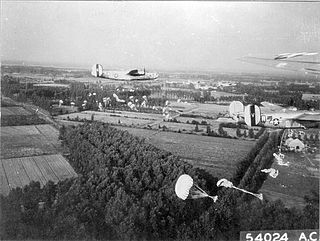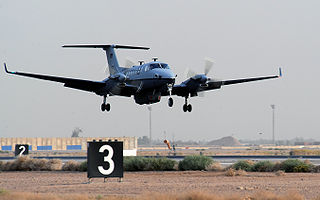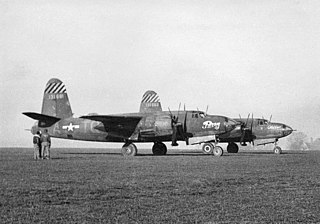
Royal Air Force Debach or more simply RAF Debach is a former Royal Air Force station located at Debach, 3 miles (4.8 km) northwest of Woodbridge, Suffolk, England.

The 493d Bombardment Group is a former United States Army Air Forces unit that was assigned to the 92d Bombardment Wing during World War II. It the last bombardment group to be assigned to Eighth Air Force. It flew combat missions in the strategic bombing campaign against Germany until shortly before V-E Day, then returned to the United States for inactivation. In 2002, the group was converted to provisional status as the 493d Air Expeditionary Group and assigned to Air Mobility Command to activate or inactivate as needed.

The 962d Airborne Air Control Squadron is part of the 3d Wing at Joint Base Elmendorf-Richardson, Alaska. It operates the Boeing E-3G Sentry aircraft conducting airborne battle management command and control missions. The squadron's first predecessor was the 862d Bombardment Squadron, a heavy bomber unit that saw combat during World War II in the European Theater of Operations, where it participated in the strategic bombing campaign against Germany. Toward the end of the war, the squadron operated fighter aircraft, acting as a scouting force for bomber formations. After V-E Day, the squadron returned the United States and was inactivated.

The 512th Rescue Squadron is part of the 58th Special Operations Wing based at Kirtland Air Force Base, New Mexico. It formerly operated the Bell UH-1N Twin Huey and currently operates the Sikorsky HH-60G Pave Hawk and the new HH-60W Jolly Green II helicopters training aircrew conducting search and rescue missions.

The 55th Air Refueling Squadron is an inactive United States Air Force unit. It formerly operated both the combat crew training school and central flight instructor course for Boeing KC-135 Stratotanker at Altus Air Force Base, Oklahoma.

The 528th Bombardment Squadron is an inactive United States Air Force unit. It was last assigned to the 380th Bombardment Wing at Plattsburgh Air Force Base, New York, where it was inactivated on 1 July 1991.

The 863rd Bombardment Squadron is a former United States Army Air Forces unit. It was first organized as the 518th Bombardment Squadron in October 1942, when it replaced a National Guard unit participating in antisubmarine patrols off the Atlantic coast, becoming the 13th Antisubmarine Squadron in November. When the Navy took over the coastal antisubmarine mission in August 1943, the squadron moved to the western United States, where it formed the cadre for the 493rd Bombardment Group and was redesignated as the 863rd. It moved to England in the spring of 1944 and participated in the strategic bombing campaign against Germany until April 1945. It returned to the United States and was inactivated in August 1945.

The 857th Bombardment Squadron is one of the two predecessors of the 557th Tactical Air Support Squadron, an inactive United States Air Force unit, formed in 1985 by the consolidation of the 857th with another inactive bombardment squadron. It has never been active under its most recent designation.

The 830th Bombardment Squadron is an inactive United States Air Force unit. Its last assignment was with the 509th Bombardment Wing at Pease Air Force Base, New Hampshire. It was active during World War II in the Mediterranean Theater of Operations as a Consolidated B-24 Liberator unit, where it participated in the strategic bombing campaign against Germany. It earned a Distinguished Unit Citation. Following V-E Day, the squadron returned to the United States and began training with the Boeing B-29 Superfortress at Smoky Hill Army Air Field, Kansas. When its parent group was inactivated in 1946, it moved to Roswell Army Air Field, New Mexico, where it joined the United States' first nuclear-capable unit, the 509th Composite Group. The squadron remained part of the 509th until it was inactivated when the wing converted to the Boeing B-52 Stratofortress.

The 506th Bombardment Squadron is an inactive United States Air Force unit. It was last assigned to the 44th Bombardment Wing at Chennault Air Force Base, Louisiana, where it was inactivated on 15 June 1960.

The 715th Weapons Squadron is an inactive United States Air Force unit. It was last assigned to the USAF Weapons School at Whiteman Air Force Base, Missouri, where it served from 2003 until 9 September 2005 as an advanced training unit with the Northrop Grumman B-2 Spirit.

The 425th Bombardment Squadron is an inactive United States Air Force unit. Its last assignment was with 308th Bombardment Wing at Plattsburgh Air Force Base, New York, where it was inactivated in 1961.

The 361st Expeditionary Reconnaissance Squadron is a provisional United States Air Force unit. It was most recently assigned to the 451st Air Expeditionary Group at Kandahar Airfield, Afghanistan, where it was inactivated on 1 September 2014.

The 456th Bombardment Squadron is one of the two predecessors of the 556th Tactical Air Support Squadron, an inactive United States Air Force unit. Formed in 1985 by the consolidation of the 456th with another inactive bombardment squadron. It has never been active under its most recent designation.

The 969th Airborne Warning and Control Squadron is an inactive United States Air Force unit. It was formed in 1985 by the consolidation of the 559th and 659th Bombardment Squadrons.

The 920th Air Refueling Squadron is an inactive United States Air Force unit. It was last assigned to the 379th Bombardment Wing at Wurtsmith Air Force Base, Michigan where it was inactivated on 30 September 1992.

The 366th Bombardment Squadron is an inactive United States Air Force unit. It was first activated in March 1942. After training with Boeing B-17 Flying Fortress bombers in the United States, the squadron deployed to the European Theater of Operations, where it participated in the strategic bombing campaign against Germany. The squadron was twice awarded the Distinguished Unit Citation for its combat actions. Following V-E Day, it moved to the continent of Europe and engaged in photographic mapping until inactivating in December 1946.

The 364th Bombardment Squadron is an inactive United States Air Force unit. Its last assignment was with the 305th Bombardment Wing at Bunker Hill Air Force Base, Indiana, where it was inactivated on 1 January 1970. The squadron was first activated in March 1942. After training in the United States, it moved to England in the fall of 1942, where it participated in the strategic bombing campaign against Germany, earning a Distinguished Unit Citation for its actions. Following V-E Day, the squadron moved to Germany, where it formed part of the occupation forces until inactivating in December 1946.

The 361st Tactical Missile Squadron is an inactive United States Air Force unit. It was formed in 1985 by the consolidation of the 1st Antisubmarine Squadron and the 661st Bombardment Squadron. However, the squadron was ever active under its new title.

The 968th Expeditionary Airborne Air Control Squadron is a provisional unit of the United States Air Force, flying the Boeing E-3G Sentry. Since March 2022, the squadron is stationed at Prince Sultan Air Base, Saudi Arabia. It has been activated twice since the September 11 terrorist attacks.
























